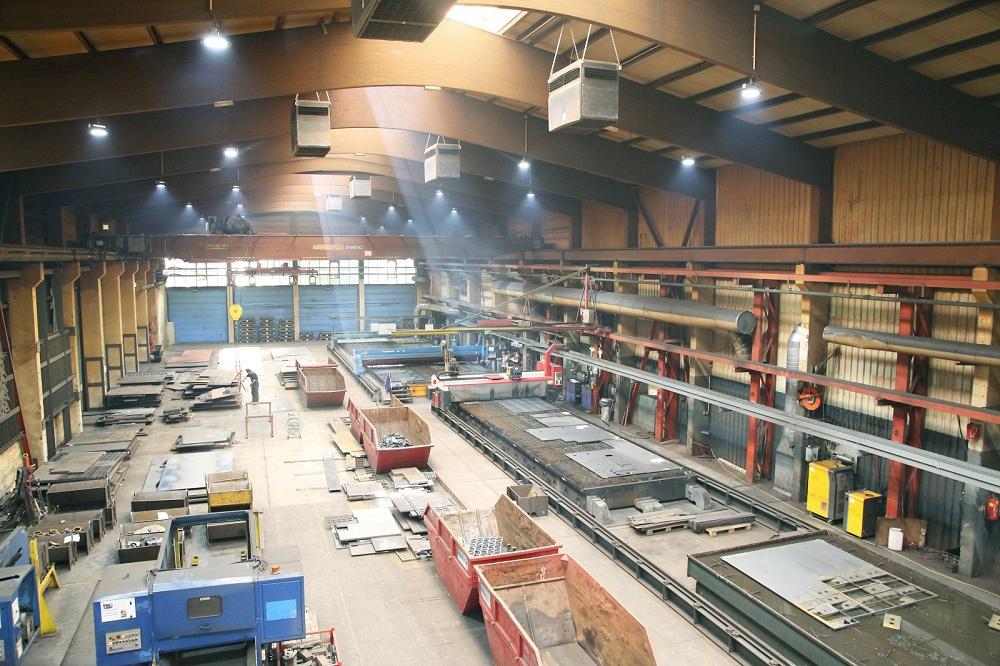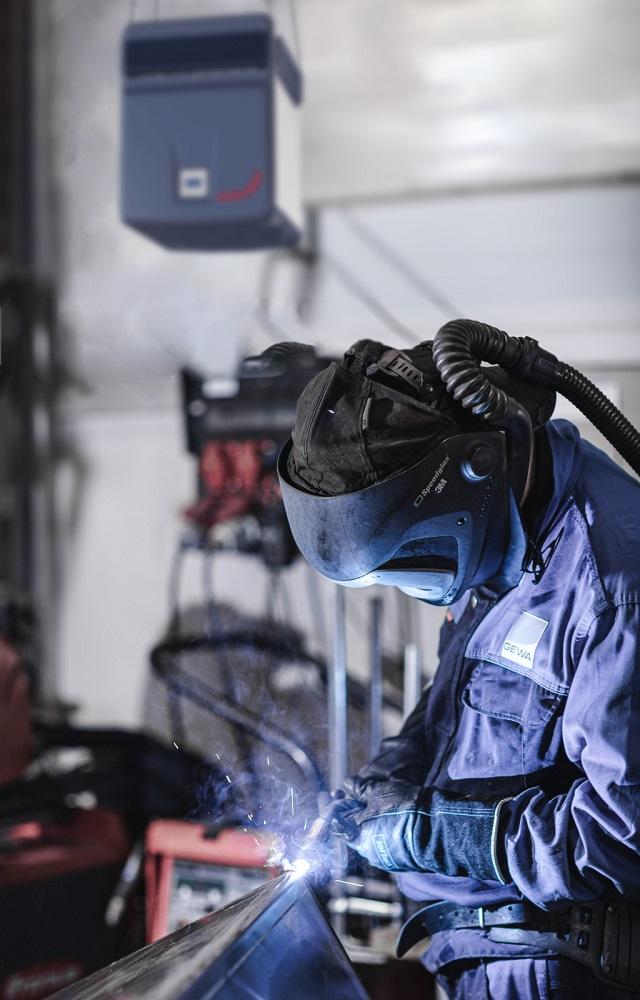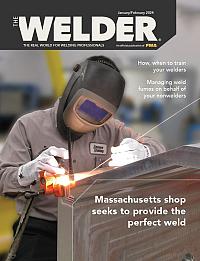Editor
- FMA
- The Fabricator
- FABTECH
- Canadian Metalworking
Categories
- Additive Manufacturing
- Aluminum Welding
- Arc Welding
- Assembly and Joining
- Automation and Robotics
- Bending and Forming
- Consumables
- Cutting and Weld Prep
- Electric Vehicles
- En Español
- Finishing
- Hydroforming
- Laser Cutting
- Laser Welding
- Machining
- Manufacturing Software
- Materials Handling
- Metals/Materials
- Oxyfuel Cutting
- Plasma Cutting
- Power Tools
- Punching and Other Holemaking
- Roll Forming
- Safety
- Sawing
- Shearing
- Shop Management
- Testing and Measuring
- Tube and Pipe Fabrication
- Tube and Pipe Production
- Waterjet Cutting
Industry Directory
Webcasts
Podcasts
FAB 40
Advertise
Subscribe
Account Login
Search
Are nonwelders in your shop at risk from welding fumes?
An industrial air cleaning company weighs in on weld fume management to keep all employees safe
- By Rafael Guerrero
- January 26, 2024
- Article
- Safety

Weld fume management isn’t solely a concern for welding bays—it is something that needs to be addressed throughout the entire shop. Images: Zehnder Clean Air Solutions
Many shops go to great lengths to limit welders’ exposure to welding fumes: weld fume extractors, respirators, ventilation improvements in welding booths. But what about limiting fume exposure for the shop’s nonwelders?
Welding fumes are not something to be ignored. Prolonged exposure can lead to short-term health problems like sinusitis, colds, and irritation of the nasal, mouth, and lung cavities; and long-term health problems like chronic lung problems, cancer, ulcers, kidney damage, and Parkinson’s disease. The resulting consequences for businesses that do not properly capture weld fumes include lower employee retention, higher absenteeism rates, and OSHA investigations and enforcement.
Industrial air cleaning company Zehnder Clean Air Solutions, Buffalo, N.Y., explored this topic in a recent study of workplace fume exposure. It coined the term “pedestrianism” to describe when nonwelders are exposed to the same fume risks as welders—even from afar—but with arguably less protection and fewer safeguards in place at their respective workstations.
“I think the main point of the topic is it’s not just the welders you have to watch out for. You need to protect all the employees in the facility,” said Kevin Rohrbach, head of North America at Zehnder Clean Air Solutions.
The Welder recently spoke to Rohrbach to discuss the Zehnder study’s findings, how to protect all shop employees, and tips to reduce or eliminate the risk of welding fumes in the workplace.
TW: What can you tell our readers about this air quality study—when was it done, how big was it, what were the results?
Kevin Rohrbach: We did a study at a manufacturing facility in the U.K., in 2021. Essentially, what we did was we took measurements using a TSI DustTrak—TSI is a third-party environmental testing company based in Minnesota. The device is about the size of a book, and it takes an intake of air every five minutes. Using a laser, it counts the particles in each one of those breaths, so to speak. We used a 10-µm impactor; basically, it measured dust particles that were 10 µm and smaller. The reason we chose it is those are the size particles that begin to make their way into the body. At 10 µm, the particles begin to get into the nasal and mouth cavities; 2.5 µm or below will make their way into the lungs; and anything 1 µm or below will begin to get absorbed into the bloodstream.
We wanted to get a feel what the exposure level was for the employees in both the welding bay and also at a nearby walkway. And what we found was that the welders were fairly protected. In addition to having fume extraction in place, they had PPE on such as welding helmets and gloves, and they had an on-torch extraction system. Relatively speaking, the company did a decent job of protecting those in the welders’ area.
What we found, though, was in the walkway just a few feet away were particle counts that were double that of the welding booth. What we determined was particulate and gases were being released from the welders’ area and continued to build up throughout the day. Those workers that were not welding were still being exposed to it and didn’t have the same level of protection that the welders had.
We came up with the word “pedestrianism” to describe that situation and try to get the message out to other companies. Extraction systems and PPE for welders is great and part of the solution, but you also have to think about the other workers. Oftentimes, we find these welding booths are in open floor plans, allowing gas and particulate to escape and build up in other parts of the building and exposing workers to high levels of particulate and gases that are harmful to their health.

Nonwelders may be exposed to the same fume risks as welders but have less protection and safeguards in place at their respective workstations. This can ultimately lead to health and non-health-related repercussions down the road.
We put the dust tracker in for a week; that’s our typical practice. The reason why we do that is oftentimes production will vary throughout the day and week. We wanted to get a true snapshot of what was going on in a typical workweek.
And again, what we found was that in the welding area it was relatively OK with the extraction system, but the walkways were double what there was in the welding area. To give you context, in the welding booth, the average recorded measurement was 550 µg/m3. If you look at a chart, it is considered unhealthy and even hazardous at times. But when we took the measurements in the walkways, the average reading was 1,000 [µg/m3], which was way into the hazardous levels. Our conclusion was that companies needed to take further action beyond just the extraction systems they have in place at the welding bay.
TW: What do you mean when you use the term “pedestrianism?”
KR: It refers to people walking around the plant. Think about somebody who may be working in the shipping/receiving area on the opposite side of the building. Someone just walking around doing their business, getting materials shipped in and out, has nothing to do with welding and would have no idea they are being exposed to those [fume] levels.
TW: Which of the nonwelders in a shop are at greater risk to exposure?
KR: In reality, the risk is the same [for everyone] if that type of material is being released into the air.
TW: Besides having a negative effect on employee health, what are some other repercussions that poor air quality can have on a business?
KR: If you look at today’s labor market, there’s a huge demand for welders. What that means is employees have more power in choosing where they want to work. If you want to compete with other companies to get those employees, you have to provide the best employee environment. It really boils down to this: Do you want to work in a dark, dirty environment which some shops have a reputation for, or do you want to work in a clean environment where you’re well protected?
There’s also the operational side of it. Anything that is oil bearing, if dirt and dust gets into this machinery, it’s going to cause issues and breakdowns. Keeping the air clean and capturing [dust and dirt] before it falls to the ground is important. One way to prevent it from hitting the ground and having a dirty environment is to capture it while it’s airborne.
TW: What can shops do to keep everyone inside their facilities safe and reduce weld fume exposure?

To help reduce or eliminate welding fumes, shops should reach out to indoor air quality experts for guidance and invest in air quality testing tools, fume extraction systems, PPE, industrial air cleaners, and HVAC systems.
KR: There’s a couple of things. I'm not here to say fume extraction systems are not part of the solution because, clearly, they are. But what we’re seeing is that companies are not buying the right systems or not maintaining them; they tend to degrade over time. They also are not designed to capture the smallest particulate. You need other things in place to protect employees.
We obviously recommend industrial air cleaning because that’s the business we’re in. But you also can look at further ventilation with your HVAC system. Make sure you’re circulating the air properly within the building. PPE is a big one—obviously with welding, you want to have the right welding helmet, MIG guns, and extractors. Masks and respirators may be part of the solution, depending on what the exposure is.
Proper ventilation, air cleaning, and extraction are the big three things you’re going to need to ensure a proper environment.
TW: Any tips or advice for those curious about this topic?
KR: First and foremost, engage with an expert, whether it’s a company like ours or another company that’s an expert in indoor air quality. They can provide guidance on the type of equipment you may need.
The other advice I would give is you don’t necessarily have to invest in an industrial hygienist right out of the gate to get an understanding of your problem. There are many hand-held devices in the marketplace that will help you understand what the health ratings are from an air quality standpoint. That will give you a nice snapshot and help guide you in where to look and how to resolve those issues.
About the Author

Rafael Guerrero
2135 Point Blvd.
Elgin, IL 60123
(815)-227-8242
Rafael Guerrero. was named editor of The Welder in April 2022. He spent nine years as a journalist in newspapers in the Midwest and Pacific Northwest, covering topics and communities in central Illinois, Washington, and the Chicago area.
About the Publication
subscribe now

The Welder, formerly known as Practical Welding Today, is a showcase of the real people who make the products we use and work with every day. This magazine has served the welding community in North America well for more than 20 years.
start your free subscription- Stay connected from anywhere

Easily access valuable industry resources now with full access to the digital edition of The Fabricator.

Easily access valuable industry resources now with full access to the digital edition of The Welder.

Easily access valuable industry resources now with full access to the digital edition of The Tube and Pipe Journal.
- Podcasting
- Podcast:
- The Fabricator Podcast
- Published:
- 04/16/2024
- Running Time:
- 63:29
In this episode of The Fabricator Podcast, Caleb Chamberlain, co-founder and CEO of OSH Cut, discusses his company’s...
- Trending Articles
Sheffield Forgemasters makes global leap in welding technology

ESAB unveils Texas facility renovation

Engine-driven welding machines include integrated air compressors

How welders can stay safe during grinding

The impact of sine and square waves in aluminum AC welding, Part I

- Industry Events
16th Annual Safety Conference
- April 30 - May 1, 2024
- Elgin,
Pipe and Tube Conference
- May 21 - 22, 2024
- Omaha, NE
World-Class Roll Forming Workshop
- June 5 - 6, 2024
- Louisville, KY
Advanced Laser Application Workshop
- June 25 - 27, 2024
- Novi, MI


























